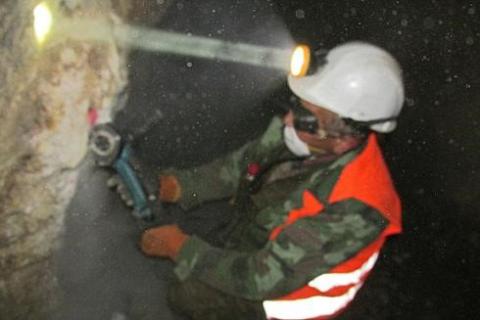Practical Exploration Geology I - Underground Channel Sampling

Underground Channel Sampling in Goražde
Mineco’s Goražde Project focuses on an abandoned antimony mine located in the Novi Goražde municipality of Bosnia Herzegovina. The antimony mineralisation is present as vein type or lenticular ore bodies located a) along the tectonic structures/faults and fractures and in b) the contact zone between altered limestone and hanging wall hosted schists/phyllitic rock.
When conducting geological exploration within underground drifts (tunnels) one of the most cost effective sampling techniques is to take “channel samples”.
The channel is usually positioned perpendicular to the structure (mineralised zone) which is to be sampled. The location is either in the wall of the drift or, sometimes, in the roof, since a lot of the historical drifts were developed “on ore” i.e. following the strike of the mineralised vein.
The length of the channel is 0.35 – 1.5 m, width 5 – 10 cm and the depth 2 – 3 cm. Before taking the sample the surface area is cleaned with water in order to improve the observation of the sample area and remove mud & clay deposits which have often built up on the walls of the drifts. Once clean the area to be sampled is marked with coloured spray.

Traditionally we used hammers and chisels to take channel samples but a far quicker and more effective technique has recently been adopted. Using a cordless battery grinder the channel is literary cut inside rock to 2-3cm depth, with two parallel lines on 5-10 cm apart for the desired length of the channel. Using the grinder allows us to achieve far more precise and therefore “representative” samples. Once the channel is cut the rock is chiselled out by hand along the length of the sample. If the rock is particularly hard the channel area is cut with diagonal lines to ease the chiselling out of the sample.
Once the channel is cut a two man team takes the sample. The first person uses a chisel and crack hammer to take the sample and the second catches the rock in a piece of PVC guttering held beneath the channel. The collected material is placed into a calico bag tagged with the sample ID number ready to be sent to the laboratory for assay.
The channel samples locations are photographed, the geologist records in his field book any visual observations and finally the channel is also numbered by nailing in a small aluminium plate, engraved with the sample ID number.
In Goražde this technique has been used to collect over 190 underground samples this year.



